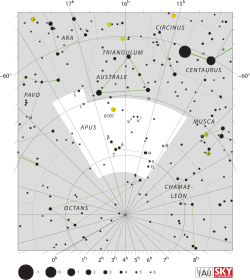Delta Apodis

| |
| Observation data Epoch J2000 Equinox J2000 | |
|---|---|
| Constellation | Apus |
| δ1 Aps | |
| Right ascension | 16h 20m 20.80462s[1] |
| Declination | –78° 41′ 44.6889″[1] |
| Apparent magnitude (V) | +4.76[2] |
| δ2 Aps | |
| Right ascension | 16h 20m 26.85843s[1] |
| Declination | –78° 40′ 02.9901″[1] |
| Apparent magnitude (V) | +5.27[2] |
| Characteristics | |
| Spectral type | M5 IIIb + K3 III[3] |
| U−B color index | +1.68/+1.62[2] |
| B−V color index | +1.69/+1.41[2] |
| Variable type | irregular variable |
| Astrometry | |
| δ1 Aps | |
| Radial velocity (Rv) | –12.0[4] km/s |
| Proper motion (μ) | RA: –10.23[1] mas/yr Dec.: –37.43[1] mas/yr |
| Parallax (π) | 4.28 ± 0.16[1] mas |
| Distance | 760 ± 30 ly (234 ± 9 pc) |
| δ2 Aps | |
| Radial velocity (Rv) | –10.2[5] km/s |
| Proper motion (μ) | RA: –1.75[1] mas/yr Dec.: –31.58[1] mas/yr |
| Parallax (π) | 5.32 ± 0.22[1] mas |
| Distance | 610 ± 20 ly (188 ± 8 pc) |
| Other designations | |
| δ1 Aps: HD 145366, HIP 80047, SAO 257380.[6] | |
| δ2 Aps: HD 145388, HIP 80057, SAO 257381.[7] | |
Delta Apodis (δ Aps, δ Apodis) is the Bayer designation for a double star in the southern constellation of Apus.
The brighter star, δ¹ Apodis, is a M-type red giant with a mean apparent magnitude of +4.68. It is classified as an irregular variable[8] star and its brightness varies from magnitude +4.66 to +4.87. At an angular separation of 102.9 arcseconds is δ² Apodis, an orange K-type giant with an apparent magnitude of +5.27.
Hipparcos data report the distance to δ¹ Apodis to be approximately 760 light years, while δ² Apodis is found to be around 610 light years from Earth. They may form a common proper motion pair.
Naming
In Chinese caused by adaptation of the European southern hemisphere constellations into the Chinese system, 異雀 (Yì Què), meaning Exotic Bird, refers to an asterism consisting of δ1 Apodis, ζ Apodis, ι Apodis, β Apodis, γ Apodis, δ Octantis, η Apodis, α Apodis and ε Apodis. Consequently, δ1 Apodis itself is known as 異雀六 (Yì Què liù, English: the Sixth Star of Exotic Bird.)[9]
References
- ↑ 1.0 1.1 1.2 1.3 1.4 1.5 1.6 1.7 1.8 1.9 van Leeuwen, F. (November 2007), "Validation of the new Hipparcos reduction", Astronomy and Astrophysics 474 (2): 653–664, arXiv:0708.1752, Bibcode:2007A&A...474..653V, doi:10.1051/0004-6361:20078357.
- ↑ 2.0 2.1 2.2 2.3 Johnson, H. L. et al. (1966), "UBVRIJKL photometry of the bright stars", Communications of the Lunar and Planetary Laboratory 4 (99), Bibcode:1966CoLPL...4...99J.
- ↑ Houk, Nancy (1979), Michigan catalogue of two-dimensional spectral types for the HD stars 1, Ann Arbor, Michigan: Dept. of Astronomy, University of Michigan, Bibcode:1978mcts.book.....H.
- ↑ Wielen, R. et al. (1999), Sixth Catalogue of Fundamental Stars (FK6). Part I. Basic fundamental stars with direct solutions (35), Astronomisches Rechen-Institut Heidelberg, Bibcode:1999VeARI..35....1W.
- ↑ Wilson, Ralph Elmer (1953), General Catalogue of Stellar Radial Velocities, Washington: Carnegie Institution of Washington, Bibcode:1953QB901.W495......
- ↑ 6.0 6.1 "del01 Aps -- Pulsating variable Star", SIMBAD (Centre de Données astronomiques de Strasbourg), retrieved 2012-07-08.
- ↑ 7.0 7.1 "HR 6021 -- Star in double system", SIMBAD (Centre de Données astronomiques de Strasbourg), retrieved 2012-07-08.
- ↑ Tabur, V. et al. (December 2009), "Long-term photometry and periods for 261 nearby pulsating M giants", Monthly Notices of the Royal Astronomical Society 400 (4): 1945–1961, arXiv:0908.3228, Bibcode:2009MNRAS.400.1945T, doi:10.1111/j.1365-2966.2009.15588.x.
- ↑ (Chinese) AEEA (Activities of Exhibition and Education in Astronomy) 天文教育資訊網 2006 年 7 月 29 日
External links
| ||||||||||||||||||||||||||||||||||||||||||||||